For more low-impact workouts and walking podcasts — plus meal plans and inspiration — download the Start TODAY app!
For those cleared by their doctor to exercise, strength and cardio workouts during all four trimesters of pregnancy are not only safe, they are healthy for you and your baby. I know firsthand that finding the energy and motivation to exercise when pregnant can sometimes be difficult, but the benefits make it worthwhile to maintain or start a fitness routine during pregnancy.
Always consult your doctor before starting a fitness routine. And listen to your body: There will be days when rest is what your body needs, so give yourself permission to take it easy!
Benefits of exercise during pregnancy
Regular physical activity during pregnancy can help manage weight gain, reduce the risk of gestational diabetes and improve overall cardiovascular health. It also helps in maintaining muscle tone, strength and endurance, which can be especially helpful during labor and delivery. Exercise can alleviate common pregnancy discomforts such as back pain, constipation and bloating, contributing to a happier, healthier pregnancy experience.
Beyond the physical benefits, working out during pregnancy also offers mental and emotional benefits. Exercise is known to boost mood and energy levels, thanks to the release of endorphins, which can help combat the fatigue and mood swings often associated with pregnancy. It can also improve sleep quality, reduce stress and enhance overall mental well-being. By maintaining a regular exercise routine, expectant mothers can foster a sense of control and empowerment, promoting a positive outlook and better preparation for the demands of motherhood.
Honorable mention: walking
The first trimester can come with nausea and fatigue that can make working out a struggle. Personally, nausea was made even worse by doing exercises that had me going up and down, or a lot of movement forward and back. As you progress through your pregnancy and your belly grows, aches and pains and a changing center of gravity may make some exercises more difficult to perform. That’s what I suggest walking as a go-to exercise for all those who are expecting.
Walking is a safe cardio activity that you can do throughout your entire pregnancy if you are cleared to exercise. It’s low-impact, great for cardiovascular health and will help you maintain strength and mobility. On days when I wasn’t feeling well or had very little energy, a walk around the block was my go-to exercise, and it often left me feeling better.
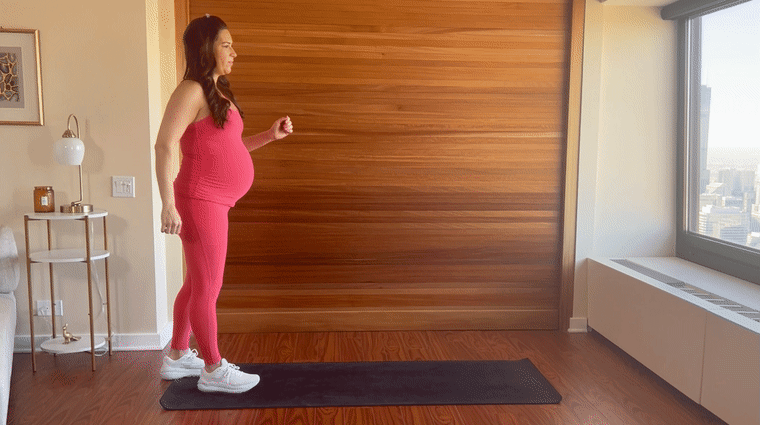
Regular walking may help prepare the body for labor by promoting optimal positioning of the baby and enhancing pelvic-floor strength. Walking can also alleviate common pregnancy discomforts such as back pain and swelling in the legs. On days when you can’t get outside for a walk, incorporate laps around the house throughout the day or opt for an indoor walking routine.
For fun indoor walking routines from Stephanie Mansour and Al Roker, check out the Start TODAY app!
When you are craving more of a workout, here are my favorite exercises to do during each trimester.
1st trimester (week 1-12)
These are some of my favorite pregnancy-safe exercises to build strength and improve mobility in the first trimester. Bonus: many of them help relieve back pain and improve stability in the low back.
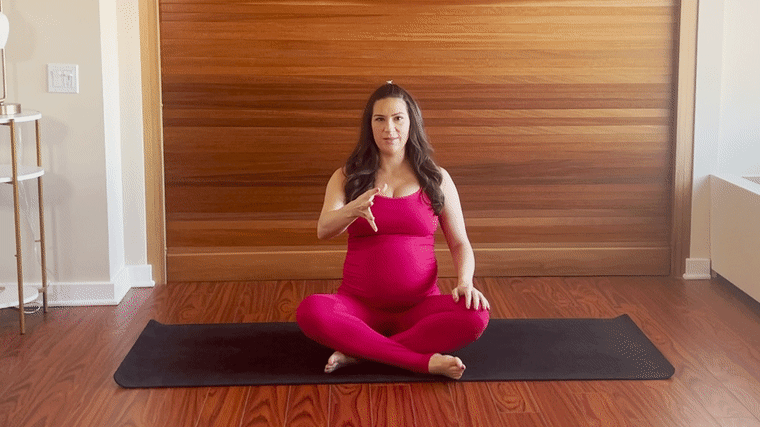
Kegels
Pelvic floor exercises are so important during your entire pregnancy. Starting in the first trimester, make it a habit to do kegels a few minutes each day. You can do them anywhere — sitting on the couch, driving in the car or lying in bed.
The pelvic floor muscles are the muscles you use to stop your urine flow midstream. Find a comfortable position, either sitting or lying down. Tighten your pelvic floor muscles and hold the contraction for 3-5 seconds. Make sure you are just using your pelvic floor muscles and not tightening your abs, thighs or glutes. Relax the muscles for 3-5 seconds. Repeat for 10 reps.
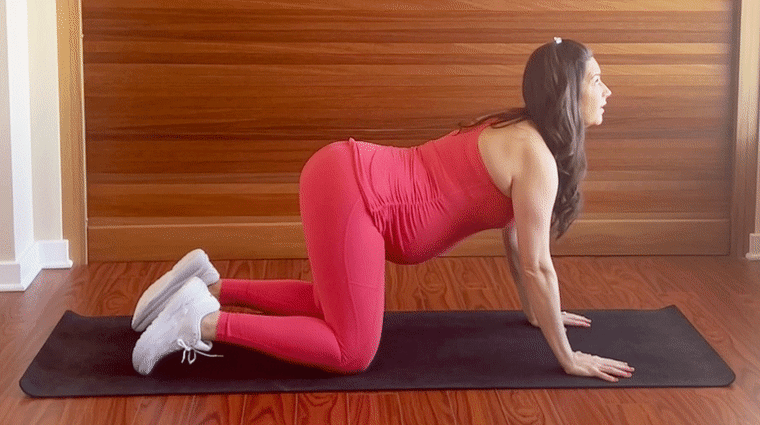
Cat cow
During pregnancy, syncing your breath with your movement helps regulate the nervous system and combat stress. Keeping the spine limber and flexible also helps as your torso prepares to grow with your baby!
Start on all fours with your hands below your shoulders and knees below your hips. Breathe in while lifting your head up toward the ceiling. Arch your back as you breathe in, moving your stomach toward the ground. Then, exhale while pulling your chin to your chest and pulling your abs in so that you arch your back toward the ceiling. Continue alternating back and forth for about one minute.
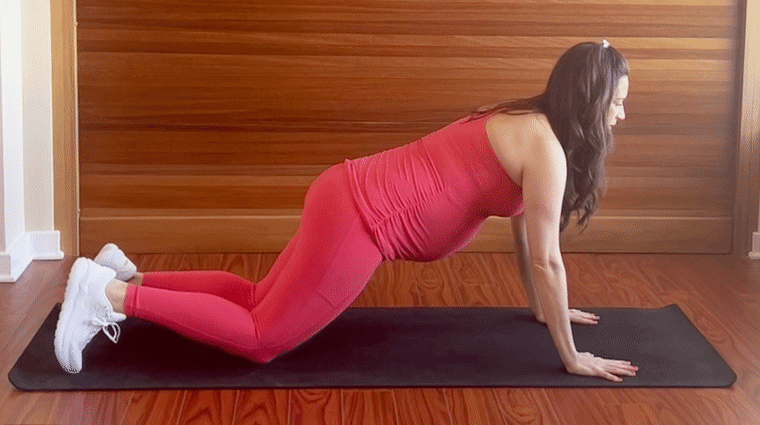
Modified pushup
Focusing on upper-body strength (to prepare you to hold your baby and all that gear!) has been a big initiative for me while being pregnant. Using modifications takes pressure off of your wrists and low back as your belly grows.
Start in a pushup position with your wrists directly below your shoulders and your palms pressing into the mat. Instead of being on your toes like in a standard pushup, rest your knees on the mat. Pull your navel in toward your spine, and ensure you maintain a straight spine from your neck to your tailbone. Begin bending your elbows slowly out to the sides, lowering your chest until your chin touches or almost touches the mat. Return to the starting position and repeat.
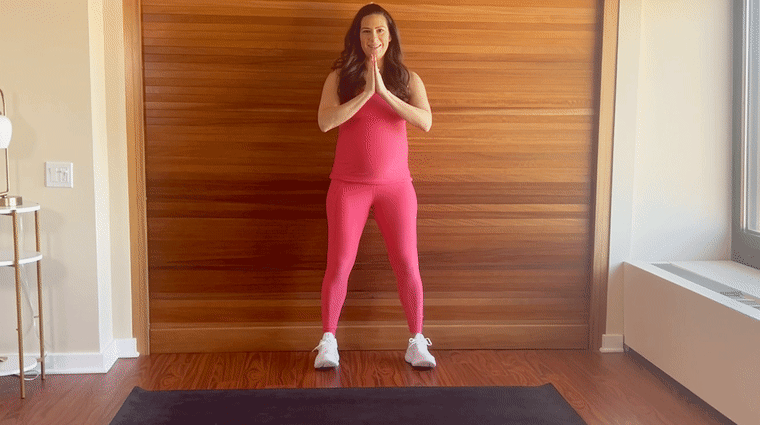
Wall sit
With the support of the wall, you will take some pressure off of your joints while putting your muscles to work. This is an especially great modification if you feel off balance during pregnancy. Strengthening the glutes, hamstrings, and quads while pregnant is great for maintaining strength and stability as our belly grows.
Lean against a wall with your back straight and your feet hip-width apart. Keep your arms at your sides as you slide down the wall, bending at the knees. Bend until your thighs are parallel to the floor. Your feet should be far enough from the wall that you form a 90-degree angle at the knee joint. Squeeze your abs and glutes and hold for a few seconds before sliding your back up the wall to the starting position. Repeat 10 times.
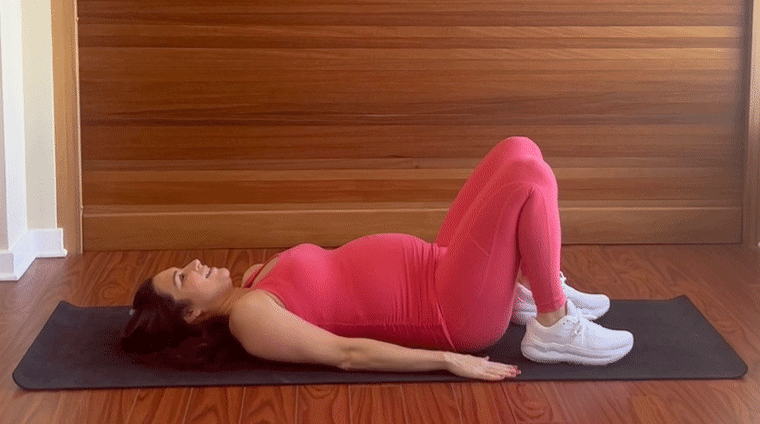
Glute bridge
I did this exercise in bed during my first trimester. Lying flat is still safe during this time, so this exercise is a great way to work the glutes and legs (and who doesn’t appreciate an exercise done lying down?).
Lie flat on your back with your knees bent and feet flat on the ground. Your knees should be hip-distance apart. Raise your hips by squeezing your glutes to create a straight line from your neck to your knees, being careful not to hyperextend your hips. Clasp your hands underneath your back for a deeper stretch or keep the arms extended on the floor, fingers pointing toward your feet. Hold the pose for 5 seconds. Don’t let your knees splay out to the side or collapse inward. Slowly lower down. Repeat 10 times.
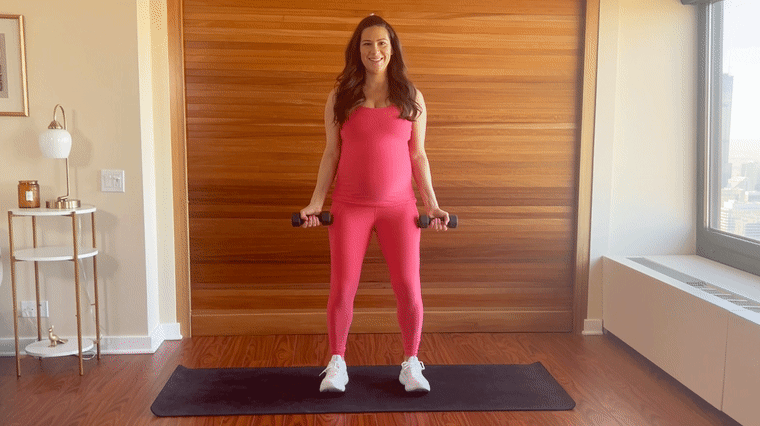
Bicep curls
This exercise is a effective and safe way to build upper-body muscle throughout your entire pregnancy. Stand tall with your feet hip-width apart. Engage your core, so that you’re balanced throughout the move, and softly bend your knees. Holding one dumbbell in each hand (I recommend starting with 5-pound weights), relax your arms so that they hang at the sides of your body. Make sure your palms are facing forward. Keep your shoulders back and down. Bend at your elbow to curl the dumbbells up toward your shoulders. Make sure to keep your elbows hugging the sides of your body. Lower both weights back down slowly. Exhale while lifting the weights, and inhale when you lower them down. Repeat for 10 repetitions.
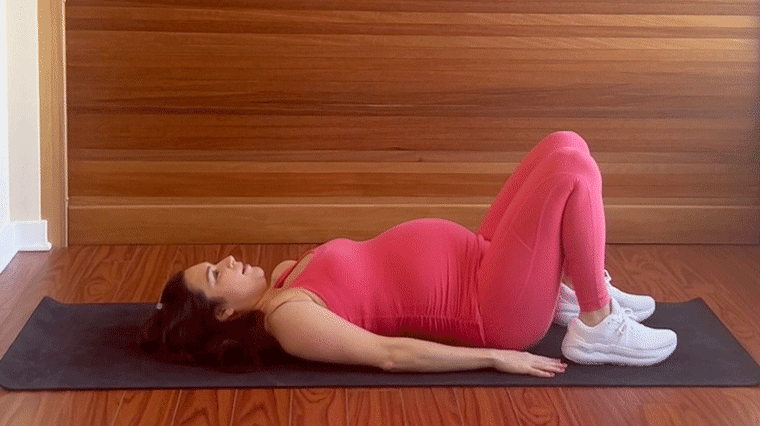
Pelvic tilt
Strengthening the core muscles in a safe way during pregnancy is always recommended. Pelvic tilts are a great move to do daily to train your body to activate the core properly and they will help improve lower-back stability. These are another one you can do in bed!
Lying on your back with your feet on the floor, open your feet as wide as your hips. Reach your arms toward your heels. Take a deep breath in through your nose and fill your stomach up with air. Then, exhale through your mouth and pull your naval in toward your spine. To exaggerate this, as you breathe in slowly arch your low back up off of the ground, keeping your tailbone planted. Then, as you exhale press your low back into the ground as you tilt your pelvis toward your ribs. Repeat these pelvic tilts forward and back 10 times.
2nd trimester (week 13-26)
After my nausea subsided, I felt like I had a new lease on life in my second trimester! I also found myself with more energy to do different movements. Here are some of my favorite strength exercises for the second trimester:
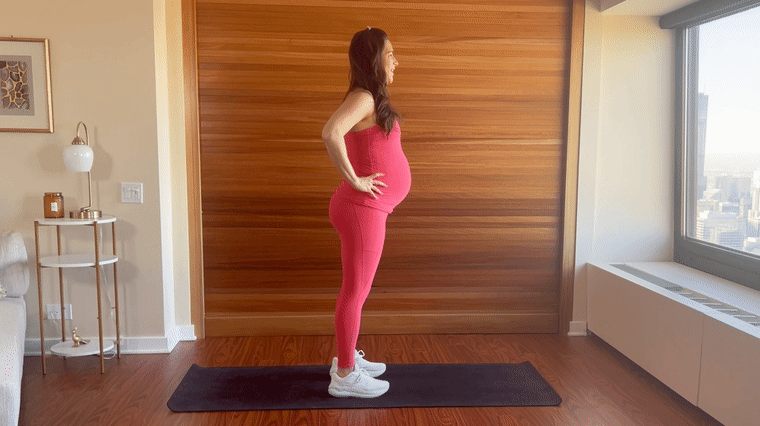
Calf raises
This exercise definitely proved to be more of a balance challenge as my belly grew! Calf raises also improve knee and ankle stability, while strengthening the lower body.
Start in a standing position with your feet hip-width apart and your core engaged. Squeezing your calf muscles, slowly raise your body, lifting your heels until you’re on your toes. Make sure to stand tall and straight. Then lower your heels back to the floor with control. Repeat.
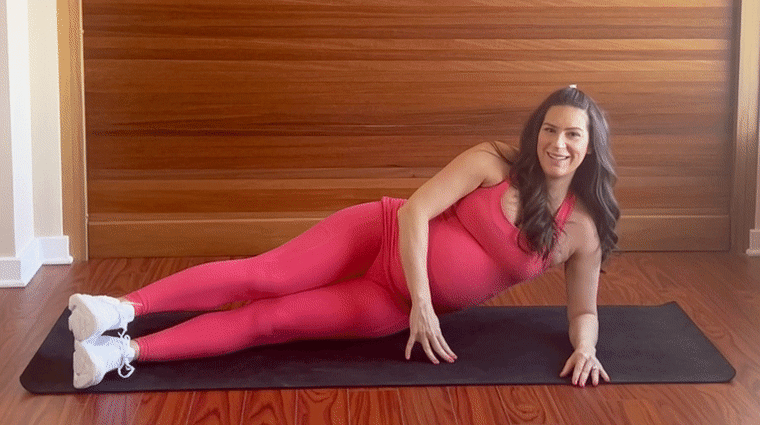
Side lying leg lifts
Standing lateral lunges can be safe for some during pregnancy. However, due to the increase in the hormone relaxin, you may have a larger range of motion, and controlling the movement by performing it lying down can be a safer and more comfortable option.
Lie down on one side with legs straight out at a slight angle from your torso and your feet stacked on top of each other. Prop your torso up with your forearm. Lift your top leg toward the ceiling in a slow and controlled movement. Point your toes to fully engage the leg. Lower it back down. Repeat 10 times and then repeat on the other side.
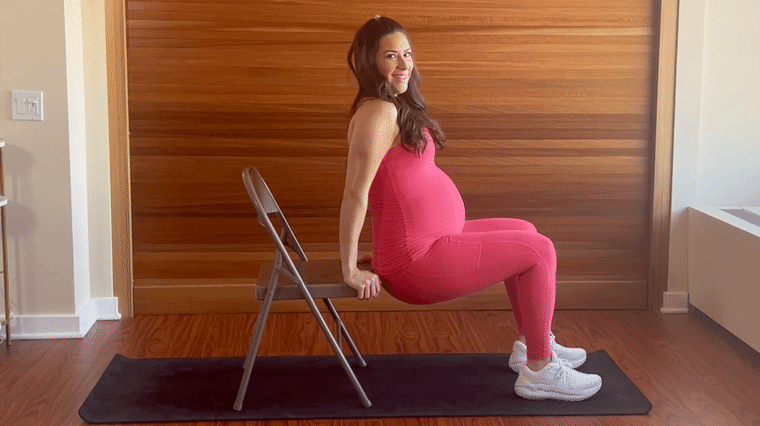
Tricep dips
Find a steady chair and take a seat. Place your hands on the chair, on either side of your hips. Grip the front of the chair, with fingers pointed toward your feet. Straighten your legs out in front of you with your heels on the ground. Keep your upper body in a straight line with your head up toward the ceiling. Move your body forward slightly so that your butt is off the chair and you are relying on your arms to hold your body weight. Lower your body down, bending your elbows at an angle somewhere between 45 and 90 degrees. Push yourself up to the starting position. Make sure to engage your core and use your triceps to move your body up and down. Perform 10 reps.
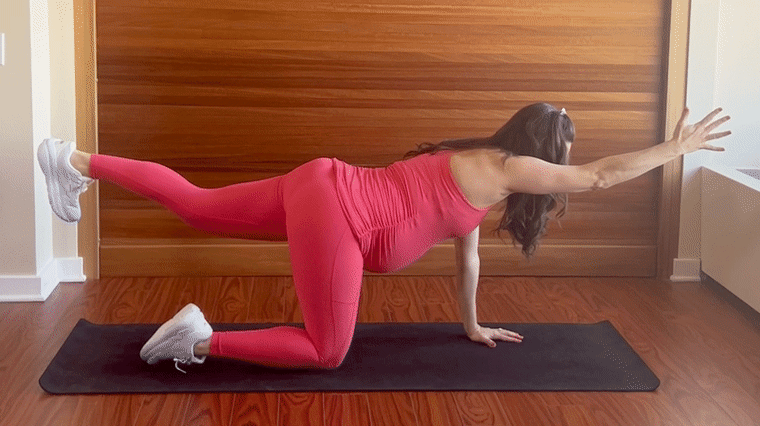
Bird dog
This is a great move that strengthens the entire core. Be sure to focus on maintaining a neutral pelvis here as your center of gravity shifts due to the growing belly.
Start on all fours with your shoulders over your wrists and hips stacked above the knees. Straighten your left arm out in front of you and your right leg out behind you, balancing on the opposite hand and knee. Hold for a few breaths. Switch sides and repeat using your right arm and left leg. Continue alternating, performing 10 reps on each side.
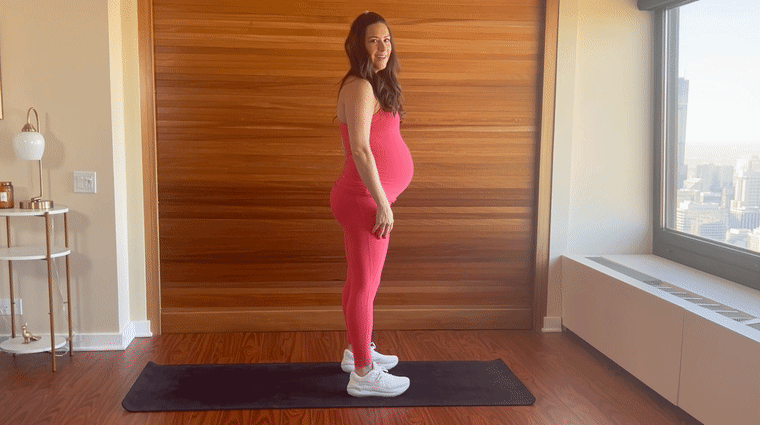
Standing pelvic tilts
The standing pelvic tilt can be performed while standing against a wall, which is a great way to master the correct form, or without the wall. Lean against the wall and bend your knees slightly. As you breathe out, tilt your pelvis up and forward, away from the wall. Your low back should press gently into the wall. Engage your abdominals to maintain proper form. Release and repeat 10 times.
3rd trimester (week 27-40)
During the final trimester of pregnancy you may feel yourself slowing down as your bump grows. I definitely felt my energy dip again during this time. Here are some of my favorite stretches to relieve pain and tension and exercises to maintain strength in the upper body, lower body and core.
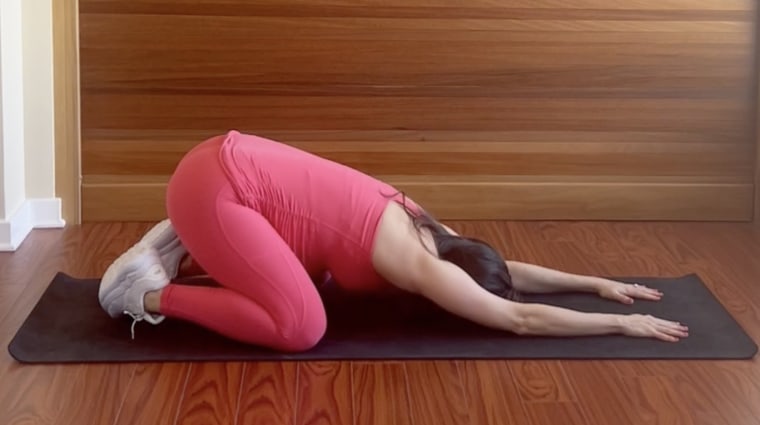
Child’s pose
This is a great stretch to release tension in the hips and low back. Kneel on the floor so that your shins and tops of your feet are on the ground. Bend at your hips, moving your hands forward and your butt back. Inch your hands out in front of you until your stomach is resting on your thighs and your arms are stretched straight out in front of you, palms on the floor. Focus on your breathing, and take it slow. Hold for as long as feels good for you.
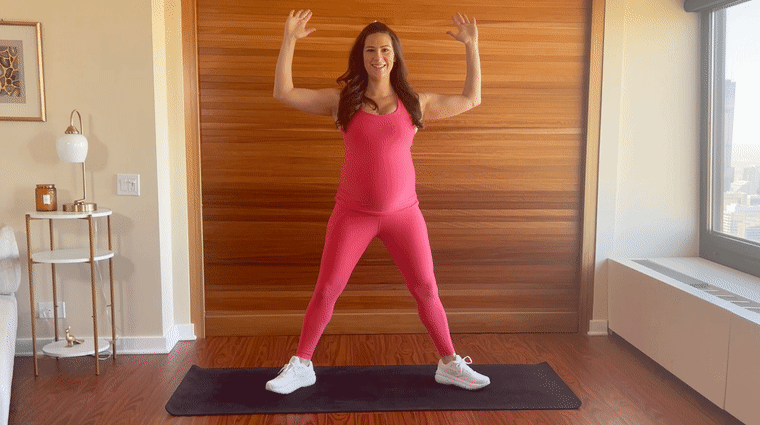
Goddess pose
Stand with your feet wider than your shoulders and your toes turned out slightly. Reach the arms up into a goal-post position. Bend the knees out toward the sides of the room, lowering the body toward the ground, and keep your back straight. Keep your pelvis tucked under by engaging your core. Ultimately, work to lower down so much that your thighs are parallel with the floor. Then press down through the heels and come back up to standing. Repeat 10 times.
Slowly move through this to maintain proper alignment and core engagement. During my third trimester, I did not go as deep into this pose because it felt like I was going past my range of motion.
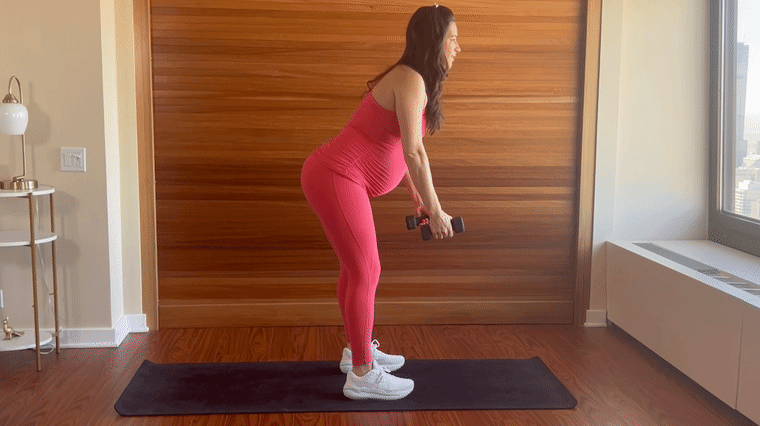
Bent-over row
Start standing with your feet hip-width apart. Hinge forward at your waist so that your torso is on a diagonal and pull your abs in. Let the weights dangle down by. Then, hug your elbows in toward your sides and pull the weights up toward your chest. Tighten your upper back and the area in between your shoulder blades. Then, lower the arms down keeping the elbows hugging in toward your sides. Repeat 10 times.
When performing exercises in a hinge position, it is important to gently pull your in abs to protect your low back. But be careful not to over-contract. Focus on tucking your pelvis and gently squeezing your abs to maintain a neutral spine.
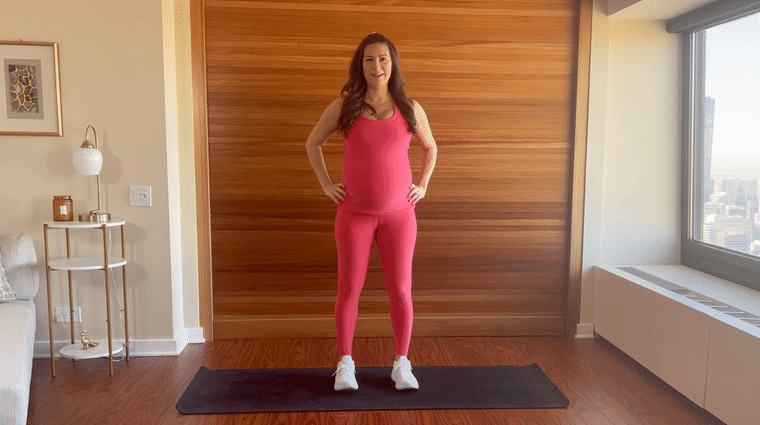
Lateral stretch
This standing move will help you stretch your obliques and entire side body. Standing with your feet hips-width apart, lift your right arm straight up into the air. Keep your left arm at your side or on your hip. Bend at the waist toward your left so that you feel a stretch in the right side of your waist. Return to the starting position and repeat on the other side.
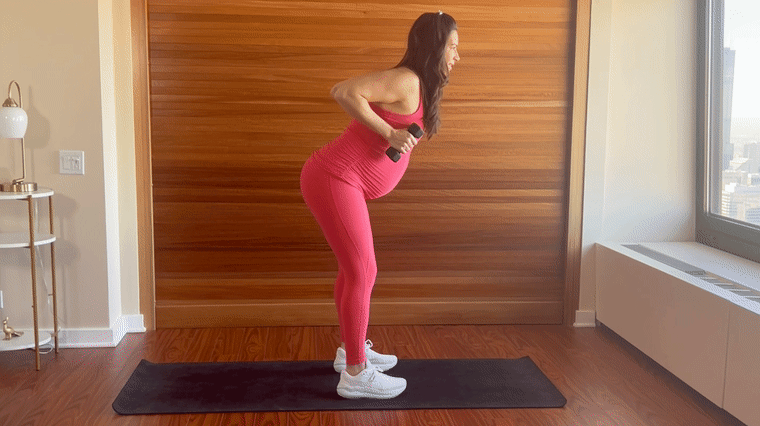
Tricep kickback
Stand with your feet hips-width apart, knees slightly bent. Hold one weight in each hand and let your arms hang down at your sides. Hinge at the hips so that your chest is tilted down toward the ground. Hug your elbows into your sides and pull your elbows up into a row. From here, keep the elbows stationary and extend the forearms back into a tricep kickback. Come back to the row position and then repeat the kickback 10 times.
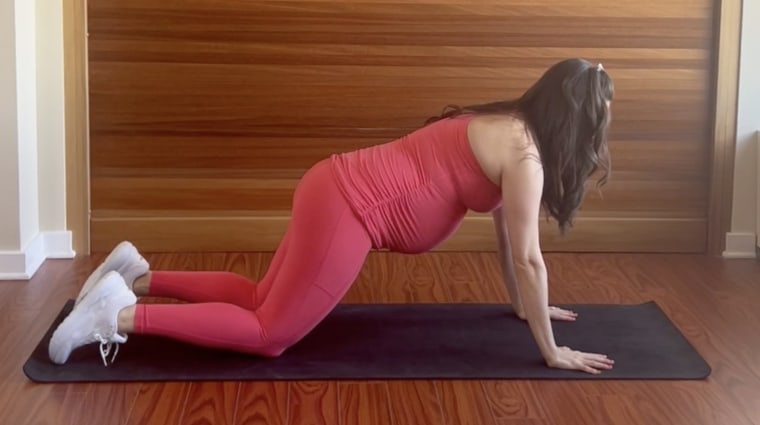
Modified plank
Planks are a great way to work not just the core, but the entire body as they engage the abdominals, legs and shoulders. As your belly grows, modifying the plank by performing it on your knees will relieve some stress from the low back and wrists.
Start on all fours with your hands directly below your shoulders. walk your knees back a few inches and shift your weight into your hands, making sure to tuck the pelvis and engage the core. If you feel too much pressure on your back, walk your knees in a bit. Hold here for 30 seconds. As I progressed later into my third trimester, I broke this into three, 10-second planks. Listen to your body and do what feels right for you.
4th trimester (the first 12 weeks after delivery)
Women are typically cleared for exercise around six weeks postpartum, but listen to your doctor and your body. Until you are ready to ease back into a strength and cardio routine, here are some gentle exercises that can aid in recovery.
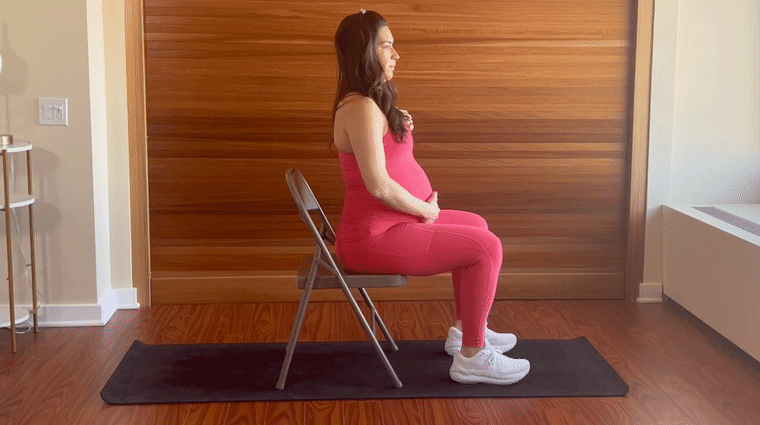
Belly breathing
Belly breathing can help you start to reconnect to your deep core muscles and is a great way to release stress and tension. And you can even do it while holding your baby! Start in a comfortable position either lying on the floor or sitting in a chair. Place one hand on your chest while placing the other just below the rib cage so that you can feel the movement of your diaphragm. Slowly breathe in through your nose for a count of five. Feel the air move in your body as your stomach rises. Then exhale the air through your mouth for a count of five, feeling your stomach relax inward.
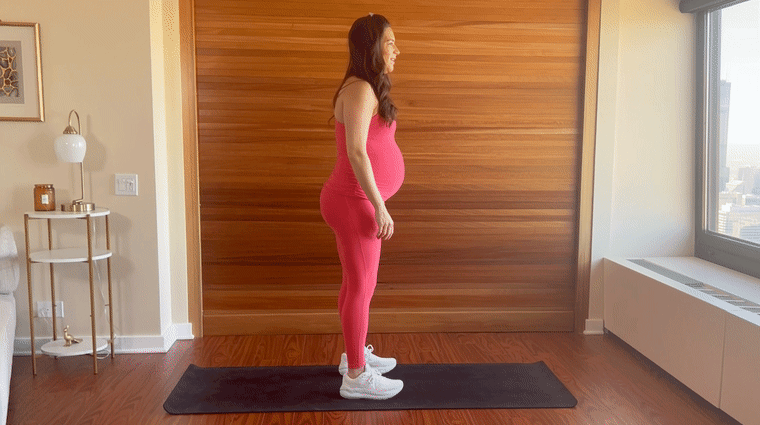
Standing forward bend
Release tension in the back of the body, especially the low back and hamstrings. Begin in a standing position. Reach the arms out to the sides and up, and then dive forward hinging at your hips. Hanging forward with a slight bend in your knees, allow your chin to rest toward your chest. Let your arms dangle. If you’re able to, try to touch your palms or fingertips to the floor on either side of your feet. Hold this for five deep breaths.
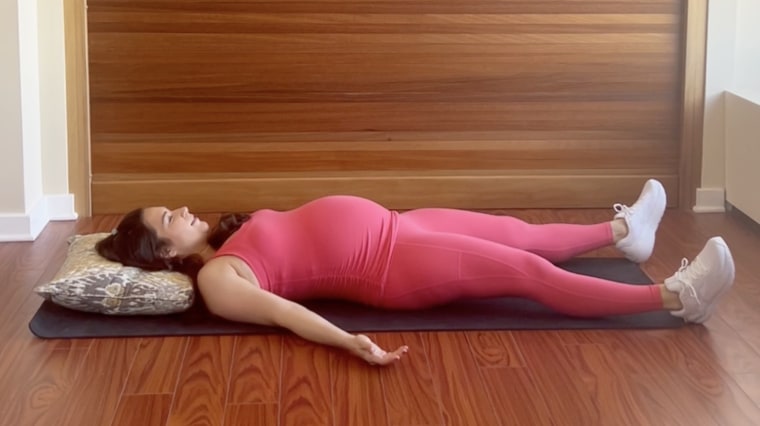
Corpse pose
Finding a few minutes to center yourself and clear your mind is much-needed during the fourth trimester! Lie down on your back with your legs and arms extended. Place the back of your hands on the mat so that your palms are facing upward. You can also place one hand on your stomach and one on your heart. Slowly breathe in through your nose and out through your nose, feeling the air rise up from your stomach into your chest, and then release. Repeat for 10 breaths.
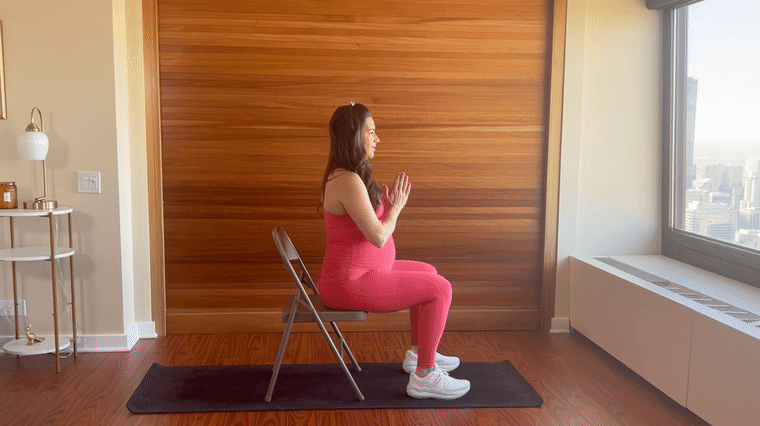
Sit and stand
This is a great way to ease back into lower-body exercises, activate the quads and glutes, and re-train your body for proper squat form if you haven’t been performing them. (Not to mention that it will be a movement you are doing quite a lot responding to the demands of baby!). Begin sitting in a chair with your back straight and arms extended straight in front of you. Without using your arms or hands, pull your body into a standing position. Once you are steady on your feet, lower back down into a seated position. Perform 10 reps.
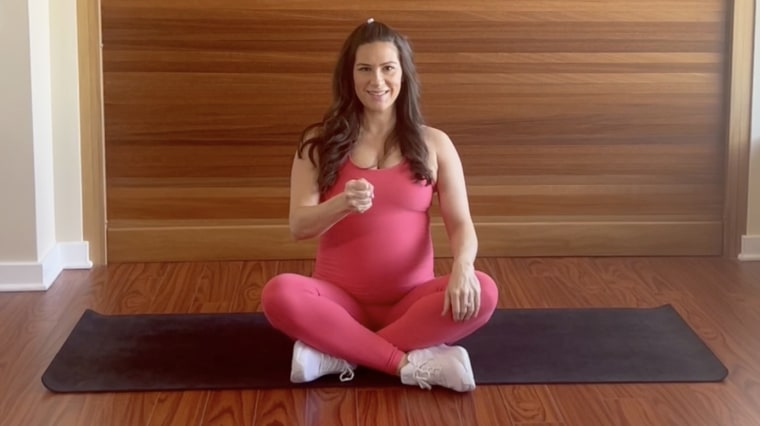
Kegels
Yes, kegels are back! They are just as important as a part of your post-natal routine as your prenatal routine! Doing kegels consistently can help repair and strengthen your pelvic floor after birth. Find a comfortable position, either sitting or lying down. Tighten your pelvic floor muscles and hold the contraction for 3-5 seconds. Make sure you are just using your pelvic floor muscles and not tightening your abs, thighs, or glutes. Relax the muscles for 3-5 seconds. Repeat for 10 reps.